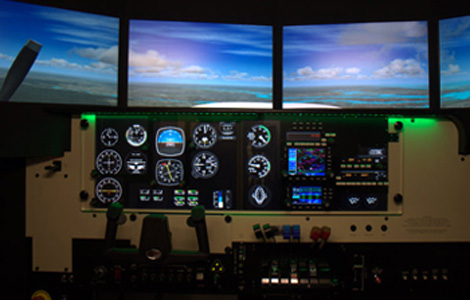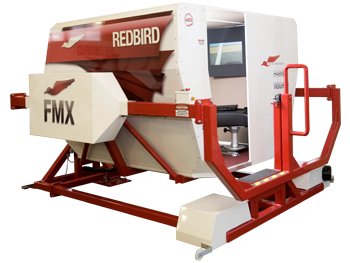Going Nowhere Fast (and Loving It)
It’s only a simulation, but it’s only half the price of a real flight
Last Monday, the Charleston Post & Courier’s business insert carried a cover story about a new company offering flight training using a simulator made by Redbird, a relative newcomer to the industry based in Austin, Texas. I’d heard lots of good things about their machines and just filed it away, but this was too close to where I live to pass up. So I made a phone call and got Mike McCurdy, the sole proprietor of Charleston Regional Advanced Flight Training (CRAFT), on the line. He sounded affable, and we set a date for later in the week.
CRAFT’s office is right at the front entrance to the Atlantic Aviation hangar at Charleston International, and I found McCurdy alone, reading something on his computer screen. The space, about 500 square feet, is dominated by the big boxy cab of a Redbird model FMX, which is classified as an Advanced Aviation Training Device (AATD) by the FAA.
Flight training has always been expensive on a comparative scale, but the recent escalation in aviation fuel cost ($6.01 per gallon average nationwide, updated September 27 on AirNav.com) and airplane prices has sent the cost, well, sky-high. When personal computers began to get powerful in the 1980s, the allure of a low-cost adjunct to in-the-airplane training created pressure on the FAA to provide manufacturers with a set of guidelines as to what a simulator would need to pass muster as a bona fide training aid. Hence FAA document AC 61-136, which spells it all out (and can be downloaded here).
McCurdy has a couple of investors, but “they’re not pilots, just interested,” he says. The Redbird machine ran them about $85k, and they rent the space at Atlantic. McCurdy and I talked flying for about half an hour, then I climbed into the cab of the Redbird to get an overview of the layout. The device can be configured through software to emulate popular light singles like the Cessna 172, and one version can replicate a Beech Baron twin. It has electrically actuated motion so the cab can be tilted to use the force of gravity to let you sense acceleration in various axes. I find that the visuals alone provide a stronger sense of motion, so we didn’t turn on the motion feature.
It’s not an airplane, so my lack of currency (I haven’t flown as a pilot in command since back in 2001 when I picked up my daughter from college one night) didn’t matter. McCurdy got me started up, prop idling on Charleston’s Runway 15. Then he basically said, “have a good time” and went back to his desk.
I did a quick cockpit check, pushed the throttle forward to the stop, and started rolling. I was headed off the runway to the left, so I pressed right rudder and soon got into a classic pilot-induced oscillation–weaving back and forth in the dreaded PIO. I pulled the throttle back to idle and kept rolling but settled back at runway center.
Try again.
I was still swerving but not too badly, and I finally pulled on the yoke and lifted off. “Outside” was a computer-generated landscape of synthetic “textures” and objects — little conical trees and some generic buildings, but no familiar local landmarks. Looking farther out, though, I could see a more familiar sight: Charleston harbor and the three principal rivers that converge there.
This “airplane” didn’t fly like any 172 I knew, but McCurdy had alerted me to that. (The simulator was less responsive to the controls and to pitch adjustments, which resulted in a tendency to wander from the intended path at lower airspeeds.) But its 172-ness wasn’t the point. Maybe I was flying a 1981 Succotash 200; didn’t matter. Whatever it was, this was a time to learn its qualities and fly it as well as I could. At about that time, I noticed that the flaps were still set at 10 degrees down, and once I stowed them to clean up, the airspeed climbed.
I did some 90-degree turns left and right and flew a couple of landings at Charleston, then asked McCurdy to put me on Asheville, North Carolina’s runway. He typed something into a keypad, and bingo! I’m sitting at idle on Runway 16. He could have put me anywhere, but Asheville was where I had gotten a lot of actual flying time, and I wondered what it might look like in the simulator. I could see I-26 running past the airport and the Duke Energy power plant that is the prominent reportable local landmark when you’re inbound, but the towns were all gone. Simulator customers who need highly accurate scenes may pay extra millions for all that code. Here it’s just not worth the extra cost. You get the terrain absolutely accurately, and that’s way more important.
I landed and shut down at AVL, then turned the machine off. I felt a bit drained, and realized that although this is simulated flying, I was still hyper-focused on the tasks of piloting an airplane that felt new and unfamiliar, and I was much more tense than I’d imagined I’d be. It also felt like an hour had passed, but it only showed between 45 and 50 minutes on the machine’s Hobbs meter, a clock used to measure the time an airplane has been running.
It costs just $75 an hour to fly this way, compared to about twice that — plus instructor time, because I couldn’t fly an airplane solo, not being current — in a real Cessna 172. In actuality, I never left the ground, but this wasn’t about traveling. It’s a little like golf or archery: par the hole or hit the bull’s eye, and the reward is a nice warm feeling of satisfaction.
McCurdy says he gets a lot of people coming through the door who always wondered what flying is like. They find out here at zero risk and low outlay, and come away from the experience knowing a little more about whether the idea of becoming a pilot is for them. I’ll be back to try it in some clouds next time. This whole thing is starting to give me ideas. Just don’t tell my wife.

